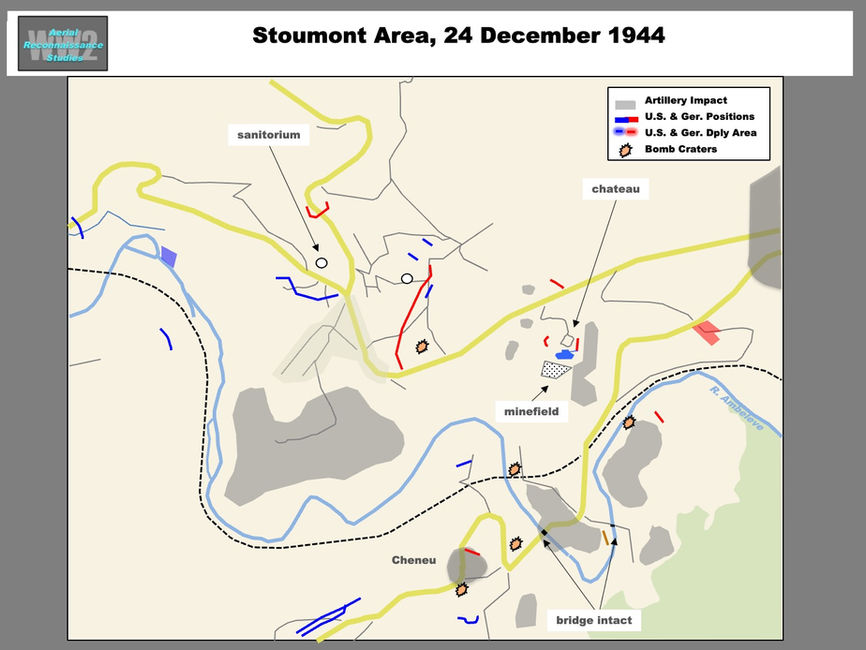WW2 AERIAL RECON STUDIES
Western Front
Battle of the Bulge Part 2: The Path of Kampfgruppe Peiper
Kampfgruppe Peiper was part of the 1st SS Panzer Division, 6th Panzer Army, assigned to the north flank of the Ardennes operation. The Kampfgruppe, commanded by Col. Joachim Peiper, was to spearhead the offensive by driving to the Meuse River crossings at Huy. Kampfgruppe Peiper was to be closely followed by the remainder of the 1st SS Panzer Division, the 12th Panzer Division and the 3rd Parachute Division. Peiper's intended route (the 6th Panzer was allotted five marchroutes) extended from Losheim and through the Losheim Gap, Schoppen, Ligeneuville, Stavelot and Werbomont.
Kampfgruppe Peiper was part of the 1st SS Panzer Division, 6th Panzer Army, assigned to the north flank of the Ardennes operation. The Kampfgruppe, commanded by Col. Joachim Peiper, was to spearhead the offensive by driving to the Meuse River crossings at Huy. Kampfgruppe Peiper was to be closely followed by the remainder of the 1st SS Panzer Division, the 12th Panzer Division and the 3rd Parachute Division. Peiper's intended route (the 6th Panzer was allotted five marchroutes) extended from Losheim and through the Losheim Gap, Schoppen, Ligeneuville, Stavelot and Werbomont.
After crossing the Amblève River at Stavelot on 18 December Kampfgruppe Peiper was denied an exit to the west by via Cheneu and Targnon. Running out of fuel and faced with stiff resistance, by 21 December the Kampfgruppe found itself trapped in a pocket between Stoumont and La Gleize (Graphic). Elements of the American 119th Inf Rgt (30th Inf Div), 82nd Airborne Div and 3rd Armored Div were closing in from the west, north and east, but at the same time, the remainder of the 1st SS Panzer Division had assembled southwest of Stavelot in a bid to relieve to the Kampfgruppe (Map).
The effort to retake the Stumont began on 20 December, with thrusts from the west (119th Inf and 740th Tank Bn, 30th Inf Div), north and east (Task Force Lovelady, McGeorge and Jordan, 3rd AD). The battle focused on a sanitorium (Graphics) at the west side of the town where, after initial success, the Americans were driven out. The Germans attempted a breakout to the west but the sanitarium was retaken on the 21st. That night the Kampfgruppe withdrew east to La Gleize. By 24 December there was no evidence of fighting at Stoumomt, but artillery and bomb impacts and foxhole lines could be seen around the sanitarium (Map 2).
While deployed at Stumont the Germans held positions at Froicourt Château on a hiil overlooking the Amblève valley. On 24 December, four tracked vehicles were deployed in a line southeast of the château and vehicle trackage indicated heavy maneuvering. It is not clear if these were abandoned German vehicles or from one of the U.S. Task Forces (Graphic). A probable minefield had been deployed on the slope southwest of the château and foxholes could be seen around the building.
Evidence of fighting could be seen in La Gleize on 24 December (Graphic 5). Fires were burning in the town and a defensive area to the southeast. At least 10 probable vehicles, including two near the present-day location of a Tiger tank ('Tiger 213'), were deployed in and around La Gelize. South of town, a possible tank was at a hedgerow that formed part of a defensive area (Graphic). The defensive area appeared to have been under attack from the southwest where heavy armored vehicle trackage could be seen coming from the forest.
On 24 December, probable elements of Task Force Lovelady (CCB 3rd Armor Div) were deployed at a roadblock between Trois Ponts and La Gleize (Graphics). The roadblock was one of three deployed along the road to keep reinforcements from reaching the Kampfgruppe. Prior to the coverage, this roadblock was cut off by German activity north and south. At least two armored vehicles were deployed in an open area and several others were parked within a group of buildings.
On its way to Stoumont on 18 December, the Kampfgruppe found an intact bridge across the Ambeleve near the town of Cheneu(Cheneux). After establishing a bridgehead, Peiper sent a detachment southwest to the vicinity of Chevron where a bridge over the Lienne Creek offered direct access to Werbomont. The bridge used by Peiper was still intact 24 December, despite evidence of bombing and artillery fire (Graphic, Map).








